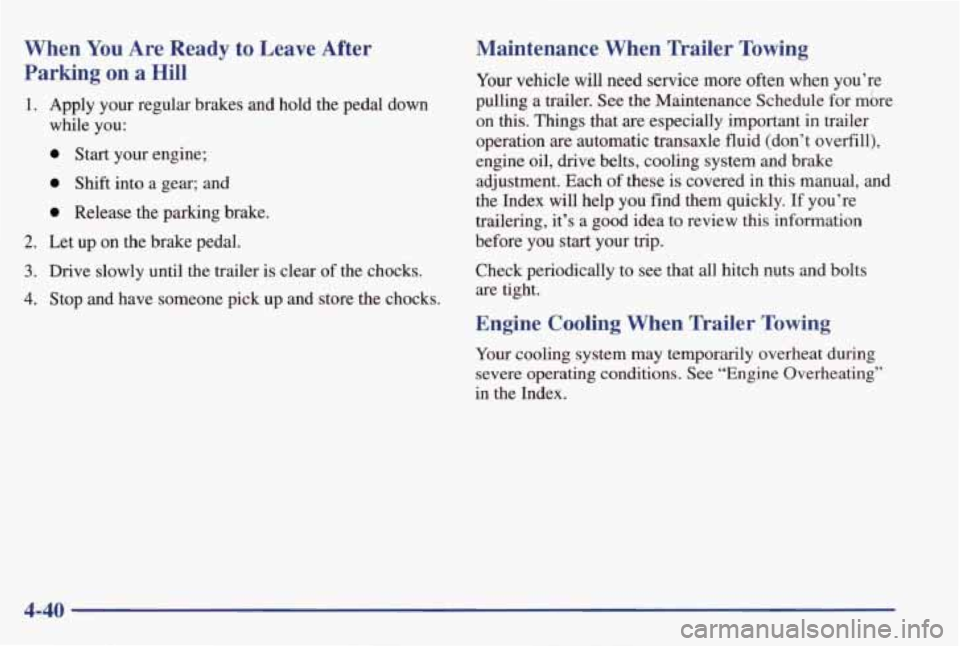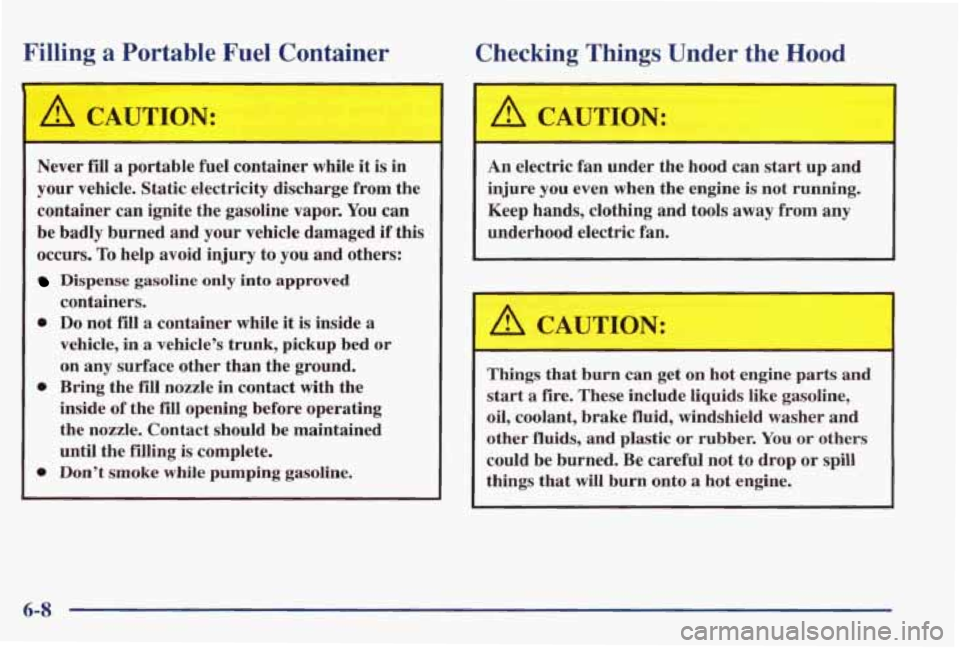Page 112 of 402
Windshield Washer
At the top of the multifunction lever, there’s a paddle
with the word
PUSH on it. To spray washer fluid on the
windshield, push the paddle. The wipers will
run for
several sweeps and then either stop or return to your
preset speed. See “Windshield Washer Fluid” in
the Index.
I A CAUTION:
Cruise Control (If Equipped)
r
In freezing weather, don’t use your washer until
the windshield is warmed. Otherwise the washer
fluid can
form ice on the windshield, blocking
your vision.
With cruise control, you can maintain a speed of about
25 mph (40 km/h) or more without keeping your foot
on the accelerator. This can really help on long trips.
Cruise control does not
work at speeds below about
25 mph (40 km/h).
When you apply your brakes, the cruise control
shuts
off.
Page 219 of 402

If you drive regularly in steep country, or if you’re
planning to visit there, here are some
tips that can make
your trips safer and more enjoyable.
Keep your vehicle in good shape. Check all fluid
levels and
also the brakes, tires, cooling system
and transaxle. These parts can work hard on
mountain roads.
Know how to go down hills. The most important
thing to know is
this: let your engine do some of the
slowing down. Shift to a lower gear when you go
down a steep or long hill.
A
/I CAUTION:
If you don’t shift down, your brakes could
get
so hot that they wouldn’t work well. You
would then have poor braking or even none going
down
a hill. You could crash. Shift down to let
your engine
assist your brakes on a steep
downhill slope.
I /I CAUTION:
Coasting downhill in NEUTRAL (N) or with the
ignition
off is dangerous. Your brakes will have to
do all the work of slowing down. They could get so
hot that they wouldn’t work well. You would then
have
poor braking or even none going down a hill.
You could crash. Always have your engine running
and your vehicle in gear when you go downhill.
e
e
e
e
Know how to go uphill. You may want to shift down
to a lower gear. The lower gears help cool your engine
and
transaxle, and you can climb the hill better.
Stay
in your own lane when driving on two-lane
roads in hills
or mountains. Don’t swing wide or cut
across the center
of the road. Drive at speeds that let
you stay in your own lane.
As you go over the top of a hill, be alert. There could be
something in your lane, like a stalled car or an accident.
You may see highway signs on mountains that warn of
special problems. Examples are long grades, passing or
no-passing zones, a falling rocks area or winding
roads. Be alert to these and take appropriate action.
4-26
Page 233 of 402

When You Are Ready to Leave After
Parking on
a Hill
1. Apply your regular brakes and hold the pedal down
while you:
0 Start your engine;
0 Shift into a gear; and
0 Release the parking brake.
2. Let up on the brake pedal.
3. Drive slowly until the trailer is clear of the chocks.
4. Stop and have someone pick up and store the chocks.
Maintenance When Trailer Towing
Your vehicle will need service more often when you’re
pulling a trailer. See the Maintenance Schedule for more
on
this. Things that are especially important in trailer
operation are automatic transaxle fluid (don’t overfill),
engine oil,
drive belts, cooling system and brake
adjustment. Each
of these is covered in this manual, and
the Index will help you find them quickly. If you’re
trailering, it’s a good idea to review
this information
before you
start your trip.
Check periodically to see that all hitch nuts and bolts
are tight.
Engine Cooling When Trailer Towing
Your cooling system may temporarily overheat during
severe operating conditions. See “Engine Overheating”
in the Index.
4-40
Page 276 of 402

Section 6 Service and Appearance Care
Here you will find information about the care of your vehicle. This section begins with service and fuel informa\
tion,
and then it shows how to check important fluid and lubricant \
levels. There
is also technical information about your
vehicle, and
a part devoted to its appearance care.
6-2
6-3
6-5
6-6
6-8
6-8
6-
13
6-20
6-22
6-26
6-32
6-33
6-36
6-37
6-44 Service
Fuel
Fuels in Foreign Countries
Filling Your Tank
Filling a Portable Fuel Container Checking Things Under the Hood
Engine Oil Air Cleaner
Automatic Transaxle Fluid
.
Engine Coolant
Windshield Washer Fluid
Brakes
Battery
Bulb Replacement
Windshield Wiper Blade Replacement 6-44
6-52
6-53 6-55
6-56
6-57
6-59
6-60
6-6 1
6-6
1
6-62
6-68
6-70
6-70 Tires
Appearance Care
Cleaning the Inside of
Your Vehicle
Care
of the Safety Belts and Built-in Child
Restraint Harness Cleaning the Outside
of Your Vehicle
Cleaning Aluminum Wheels
(If Equipped)
Underbody Maintenance
Appearance Care Materials Chart
Vehicle Identification Number (VIN)
Service
Parts Identification Label
Electrical System
Capacities and Specifications Normal Maintenance Replacement
Parts
Air Conditioning Refrigerants
Page 283 of 402

Filling a Portable Fuel Container
A CAUTION:
Never fill a portable fuel container while it is in
your vehicle. Static electricity discharge from the
container can ignite the gasoline vapor. You can
be badly burned and your vehicle damaged
if this
occurs.
To help avoid injury to you and others:
Dispense gasoline only into approved
containers.
0 Do not fill a container while it is inside a
vehicle, in a vehicle’s trunk, pickup bed
or
on any surface other than the ground.
0 Bring the fill nozzle in contact with the
1 inside of the fill opening before operating
the nozzle. Contact should be maintained
1 until the filling is complete.
~ 0 Don’t smoke while pumping gasoline.
i
Checking Things Under the Hood
A CAUTION: I
An electric fan under the hood can start up and
injure you even when the engine
is not running.
Keep hands, clothing and tools away from any
underhood electric fan.
Things that burn can get on hot engine parts and
start a fire. These include liquids like gasoline,
1 oil, coolant, brake fluid, windshield washer and
other fluids, and plastic
or rubber. You or others
could be burned. Be careful not to drop or
spill
things that will burn onto a hot engine.
6-8
Page 285 of 402
When you open the hood of the 3100 engine, you'll see:
n
A. Windshield Washer Fluid
B. Battery
C. Radiator Fill Cap
D. Power Steering
Fluid Reservoir
E. Engine Oil Fill Cap
E Engine Oil Dipstick G.
Automatic Transaxle Dipstick
H. Brake Fluid Reservoir
I. Engine Coolant Reservoir
J. Air Cleaner
6-10
Page 286 of 402
When you open the hood of the 3800 engine, you’ll see:
A. Windshield Washer Fluid
D. Power Steering G. Automatic Transaxle Dipstick
B. Battery Fluid Reservoir
H. Brake Fluid Reservoir
C.
Radiator Fill Cap E. Engine Oil Dipstick I. Engine Coolant Reservoir
E Engine Oil Fill
Cap J. Air Cleaner
6-11
Page 287 of 402
When you open the hood of the 3800 Supercharged engine, you'll see:
D. Power Steering
Fluid Reservoir
E. Engine Oil Dipstick
F. Engine Oil Fill Cap
G. Automatic Transaxle Dipstick
H. Brake Fluid Reservoir
I. Engine Coolant Reservoir
J. Air Cleaner
A. Windshield Washer Fluid
B. Battery
C. Radiator Fill Cap
6-12